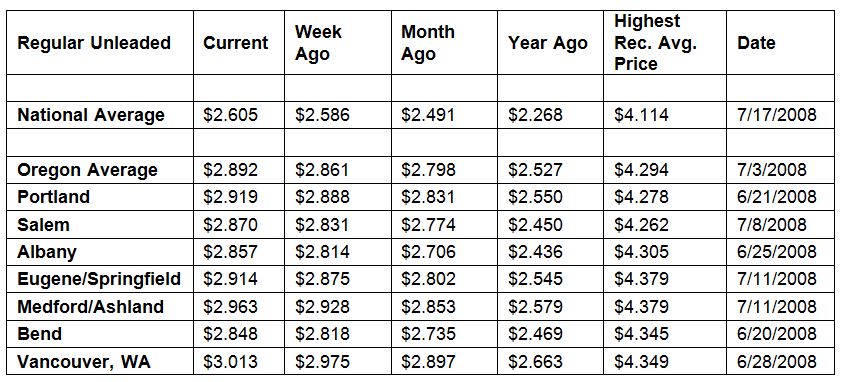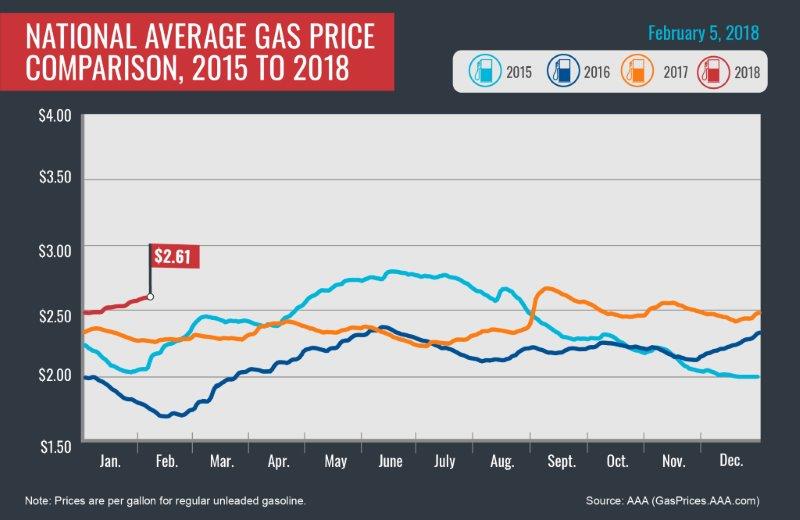PORTLAND, Ore., – Pump prices are on the rise for the sixth consecutive week. Since Christmas, the national average has tacked on 16 cents and the Oregon average has increased 11 cents. For the week, the national average for regular unleaded ticks up two cents to $2.61 a gallon while the Oregon average adds three cents to $2.89.
“Gasoline costs more in every state than one year ago. Strong demand for gas plus higher crude oil prices mean consumers will continue to pay more at the pumps,” says Marie Dodds, public affairs director for AAA Oregon/Idaho.
The U.S. Energy Information Administration (EIA) reports that gasoline demand hit 9 million b/d for the week. In 2017, demand did not reach this mark until early March.
Oregon is one of 43 states and the District of Columbia where gas prices are higher week-over-week. The largest increases are in California (+6 cents) and Florida (+6 cents). The largest weekly decrease is in Missouri (-1 cent). One state, Mississippi, has the same average as a week ago.
Oregon is one of 48 states and the District of Columbia where prices are higher now than a month ago. The national average is 11 cents more and the Oregon average is nine cents more than a month ago. The largest monthly increases are in California (+20 cents) and Iowa (+20 cents). The only two states with monthly decreases are Alaska (-6 cents) and Illinois (down fractions of a cent).
The West Coast still has the most expensive gas prices in the nation with six of the top ten markets in this region. Hawaii tops the list, followed by California and Alaska. This week Washington joins these states as the four with averages at or above $3 a gallon. After two weeks at sixth, Oregon moves up to fifth this week.
| Rank | Region | Price on 2/6/18 | |
| 1 | Hawaii | $3.40 | |
| 2 | California | $3.35 | |
| 3 | Alaska | $3.06 | |
| 4 | Washington | $3.00 | |
| 5 | Oregon | $2.89 | |
| 6 | Pennsylvania | $2.89 | |
| 7 | District of Columbia | $2.79 | |
| 8 | New York | $2.77 | |
| 9 | Nevada | $2.76 | |
| 10 | Connecticut | $2.75 |
According to the EIA, gasoline stocks in this region dropped by the largest amount seen in the last 12 weeks – nearly 700,000 bbl. Inventories of gasoline sit at 33.9 million bbl, which is still 3.3 million bbl higher than last year’s level at the same time.
The nation’s cheapest markets are Texas ($2.36) and South Carolina ($2.37). For the 28th week in a row, no states have an average below $2.
Drivers in all 50 states and the District of Columbia are paying are paying more than a year ago to fill up. The national average is 34 cents more and the Oregon average is 37 cents more than a year ago. This is the sixth-largest yearly increase in the country. California has the greatest year-over-year increase of 52 cents; Indiana is second at 50 cents, Michigan is third at 43 cents, Ohio is fourth at 41 cents and New Jersey is fifth at 38 cents.
Oil Market Dynamics
Crude oil prices started the year above $60 per barrel and that’s where they remain. Oil prices slipped a little last week after EIA’s latest weekly report revealed that crude inventories grew by an astonishing 6.8 million b/d. A stronger dollar is also putting downward pressure on crude prices. Crude oil is brought and sold in dollars, so a stronger dollar makes oil cost more for foreign buyers.
The crude oil growth may give the market some pause as it assesses the long-term impact of OPEC’s production reduction agreement, which remains in effect through the end of 2018. Countries outside of the agreement, such as the U.S., have seen production grow as global demand has grown, enabling these countries to export more oil while OPEC and its allies reduce production.
In the U.S., crude production continues to grow. The latest Baker Hughes, Inc. report found the active oil rig count in the U.S. grew by six and now totals 765. The current total is 182 more rigs than last year’s count in early February.
At the close of Friday’s formal trading session on the NYMEX, WTI decreased 35 cents to settle at $65.45. At the close of Monday’s formal trading session on the NYMEX, WTI fell $1.30 to settle at $64.15. Today crude is trading around $64, same as a week ago. Crude prices are up about three percent in the last month and are about $10 more per barrel than a year ago.
Drivers can find current gas prices along their route with the free AAA Mobile app for iPhone, iPad and Android. The app can also be used to map a route, find discounts, book a hotel and access AAA roadside assistance. Learn more at AAA.com/mobile.
Diesel
For the week, the national average gains two cents to $2.999 a gallon. Oregon’s average adds a penny to $3.09. A year ago the national average for diesel was $2.51 and the Oregon average was $2.67.
Find current fuel prices at GasPrices.AAA.com.
AAA news releases, high resolution images, broadcast-quality video, fact sheets and podcasts are available on the AAA NewsRoom at NewsRoom.AAA.com.



